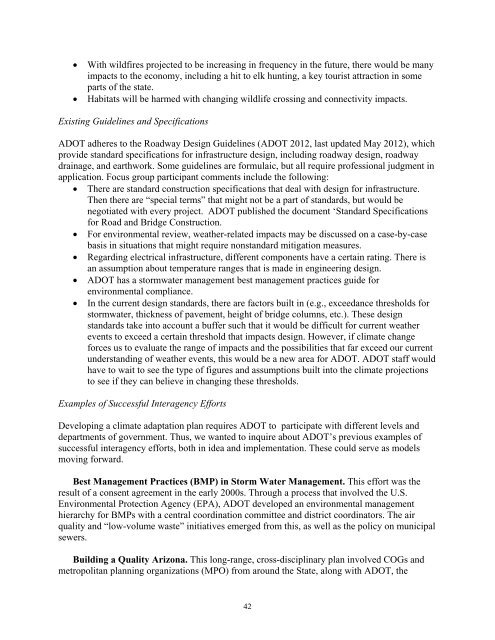SPR-696: Preliminary Study of Climate Adaptation for the Statewide ...
SPR-696: Preliminary Study of Climate Adaptation for the Statewide ...
SPR-696: Preliminary Study of Climate Adaptation for the Statewide ...
Create successful ePaper yourself
Turn your PDF publications into a flip-book with our unique Google optimized e-Paper software.
With wildfires projected to be increasing in frequency in <strong>the</strong> future, <strong>the</strong>re would be manyimpacts to <strong>the</strong> economy, including a hit to elk hunting, a key tourist attraction in someparts <strong>of</strong> <strong>the</strong> state.Habitats will be harmed with changing wildlife crossing and connectivity impacts.Existing Guidelines and SpecificationsADOT adheres to <strong>the</strong> Roadway Design Guidelines (ADOT 2012, last updated May 2012), whichprovide standard specifications <strong>for</strong> infrastructure design, including roadway design, roadwaydrainage, and earthwork. Some guidelines are <strong>for</strong>mulaic, but all require pr<strong>of</strong>essional judgment inapplication. Focus group participant comments include <strong>the</strong> following: There are standard construction specifications that deal with design <strong>for</strong> infrastructure.Then <strong>the</strong>re are “special terms” that might not be a part <strong>of</strong> standards, but would benegotiated with every project. ADOT published <strong>the</strong> document ‘Standard Specifications<strong>for</strong> Road and Bridge Construction. For environmental review, wea<strong>the</strong>r-related impacts may be discussed on a case-by-casebasis in situations that might require nonstandard mitigation measures. Regarding electrical infrastructure, different components have a certain rating. There isan assumption about temperature ranges that is made in engineering design. ADOT has a stormwater management best management practices guide <strong>for</strong>environmental compliance. In <strong>the</strong> current design standards, <strong>the</strong>re are factors built in (e.g., exceedance thresholds <strong>for</strong>stormwater, thickness <strong>of</strong> pavement, height <strong>of</strong> bridge columns, etc.). These designstandards take into account a buffer such that it would be difficult <strong>for</strong> current wea<strong>the</strong>revents to exceed a certain threshold that impacts design. However, if climate change<strong>for</strong>ces us to evaluate <strong>the</strong> range <strong>of</strong> impacts and <strong>the</strong> possibilities that far exceed our currentunderstanding <strong>of</strong> wea<strong>the</strong>r events, this would be a new area <strong>for</strong> ADOT. ADOT staff wouldhave to wait to see <strong>the</strong> type <strong>of</strong> figures and assumptions built into <strong>the</strong> climate projectionsto see if <strong>the</strong>y can believe in changing <strong>the</strong>se thresholds.Examples <strong>of</strong> Successful Interagency Ef<strong>for</strong>tsDeveloping a climate adaptation plan requires ADOT to participate with different levels anddepartments <strong>of</strong> government. Thus, we wanted to inquire about ADOT’s previous examples <strong>of</strong>successful interagency ef<strong>for</strong>ts, both in idea and implementation. These could serve as modelsmoving <strong>for</strong>ward.Best Management Practices (BMP) in Storm Water Management. This ef<strong>for</strong>t was <strong>the</strong>result <strong>of</strong> a consent agreement in <strong>the</strong> early 2000s. Through a process that involved <strong>the</strong> U.S.Environmental Protection Agency (EPA), ADOT developed an environmental managementhierarchy <strong>for</strong> BMPs with a central coordination committee and district coordinators. The airquality and “low-volume waste” initiatives emerged from this, as well as <strong>the</strong> policy on municipalsewers.Building a Quality Arizona. This long-range, cross-disciplinary plan involved COGs andmetropolitan planning organizations (MPO) from around <strong>the</strong> State, along with ADOT, <strong>the</strong>42
















